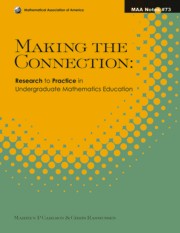Book contents
- Frontmatter
- Preface
- Contents
- Part 1 Student Thinking
- Part 2 Cross-Cutting Themes
- 2a Interacting with Students
- 13 Meeting New Teaching Challenges: Teaching Strategies that Mediate Between All Lecture and All Student Discovery
- 14 Examining Interaction Patterns in College-Level Mathematics Classes: A Case Study
- 15 Mathematics as a Constructive Activity: Exploiting Dimensions of Possible Variation
- 16 Supporting High Achievement in Introductory Mathematics Courses: What We Have Learned from 30 Years of the Emerging Scholars Program
- 2b Using Definitions, Examples and Technology
- 17 The Role of Mathematical Definitions in Mathematics and in Undergraduate Mathematics Courses
- 18 Computer-Based Technologies and Plausible Reasoning
- 19 Worked Examples and Concept Example Usage in Understanding Mathematical Concepts and Proofs
- 2c Knowledge, Assumptions, and Problem Solving Behaviors for Teaching
- 20 From Concept Images to Pedagogic Structure for a Mathematical Topic
- 21 Promoting Effective Mathematical Practices in Students: Insights from Problem Solving Research
- 22 When Students Don't Apply the Knowledge You Think They Have, Rethink Your Assumptions about Transfer
- 23 How Do Mathematicians Learn To Teach? Implications from Research on Teachers and Teaching for Graduate Student Professional Development
- About the Editors
13 - Meeting New Teaching Challenges: Teaching Strategies that Mediate Between All Lecture and All Student Discovery
from Part 2 - Cross-Cutting Themes
- Frontmatter
- Preface
- Contents
- Part 1 Student Thinking
- Part 2 Cross-Cutting Themes
- 2a Interacting with Students
- 13 Meeting New Teaching Challenges: Teaching Strategies that Mediate Between All Lecture and All Student Discovery
- 14 Examining Interaction Patterns in College-Level Mathematics Classes: A Case Study
- 15 Mathematics as a Constructive Activity: Exploiting Dimensions of Possible Variation
- 16 Supporting High Achievement in Introductory Mathematics Courses: What We Have Learned from 30 Years of the Emerging Scholars Program
- 2b Using Definitions, Examples and Technology
- 17 The Role of Mathematical Definitions in Mathematics and in Undergraduate Mathematics Courses
- 18 Computer-Based Technologies and Plausible Reasoning
- 19 Worked Examples and Concept Example Usage in Understanding Mathematical Concepts and Proofs
- 2c Knowledge, Assumptions, and Problem Solving Behaviors for Teaching
- 20 From Concept Images to Pedagogic Structure for a Mathematical Topic
- 21 Promoting Effective Mathematical Practices in Students: Insights from Problem Solving Research
- 22 When Students Don't Apply the Knowledge You Think They Have, Rethink Your Assumptions about Transfer
- 23 How Do Mathematicians Learn To Teach? Implications from Research on Teachers and Teaching for Graduate Student Professional Development
- About the Editors
Summary
A growing number of postsecondary mathematics educators are exploring teaching strategies other than lecture (Holton, 2001). The motivations for such change include personal dissatisfaction with student learning, students' poor retention of knowledge, student dissatisfaction with their undergraduate experiences in science, mathematics, and engineering (National Science Foundation, 1996; Seymour & Hewitt, 1997), as well as efforts to rethink core courses such as calculus, linear algebra, and differential equations. As postsecondary educators make changes to their practice they often struggle with many of the same issues that K–12 mathematics teachers encounter as they attempt to change their practice. In this chapter we address one of these issues, namely the role of teacher lecture (or telling) and strategies that teachers can use to balance student discovery and teacher telling.
Navigating a new terrain of teaching practice is particularly tricky for any teacher, elementary or university, who may never have experienced as a learner an approach to teaching other than lecture and demonstration. For example, some teachers believe that changes in practice must be dramatic and involve a total abandonment of lecture (where the teacher has all the responsibility for developing the mathematics) to a form of practice that leaves students to discover all ideas and techniques for solving problems. These are two ends of a continuum from all student discovery to all teacher telling. How, why, and when a teacher positions him or herself along this continuum is a source of tension for teachers.
- Type
- Chapter
- Information
- Making the ConnectionResearch and Teaching in Undergraduate Mathematics Education, pp. 167 - 178Publisher: Mathematical Association of AmericaPrint publication year: 2008
- 5
- Cited by



